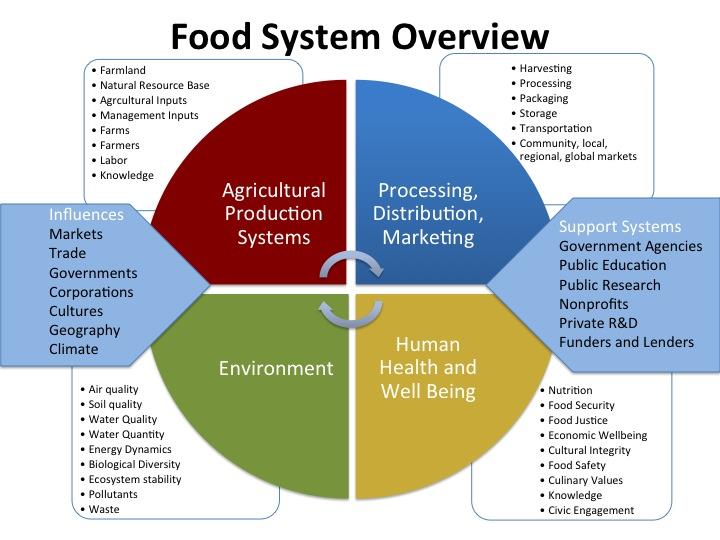Delineating boundaries within a food system context can be challenging since the core components are interconnected and operate at multiple levels from the household to the global. Food supply chains do not function in distinct “local” or “global” spheres, but are interdependent and strongly shaped by larger environmental, socioeconomic, geographical, and political contexts. Below are working definitions and descriptions of key terms.
Food System
A food system is an interconnected web of human activities that links food production, processing, distribution, and consumption with human health and the environment. Organizing frameworks operate at multiple, interdependent scales from household to agroecosystem, community, regional, state, national, and global levels. All aspects of food systems are shaped by their cultural, socioeconomic, political, and environmental contexts.
Community Food System
The concept of a community food system integrates food production, processing, distribution, marketing, and consumption in the context of a particular place. The geographic boundaries of a community food system “can be as small as a neighborhood or as large as a town or city, including its nearby growing region” as determined by the residents themselves (Garrett and Feenstra 2001). The concept typically encompasses goals of food security and equitable access to healthy foods, improving the well-being of farmers and farmworkers, and optimizing environmental and economic benefits.

Regional Food System
At a regional level, an integrated food system creates shorter, place-based linkages between producers and consumers across all aspects of the food supply chain from agricultural production systems through processing, distribution, retail, consumption, and waste management. Goals for regional food systems might include environmental benefits, economic development, human health and well-being, and social equity.
A region may refer to a community and its surrounding growing regions, multiple geographically linked counties, a watershed, a bioregion, or a political boundary such as a state or multi-state region. Midscale food supply chains can play an important role in aggregating products from multiple small and mid-scale farms to scale up regional food provision while maintaining unique product attributes (Stevenson, et al. 2011). The recent USDA Report to Congress, “Trends in U.S. Local and Regional Food Systems” (Low et al. 2015) found that participation in regional food systems is growing nationwide.
Local Food System
While the concept of “local food” has gained a wide following among consumers, retailers, and the media, there is no consensus on a geographical definition of a distance between the producer and the consumer that constitutes “local” and “there is no generally accepted definition of “local food” (Martinez et al 2010: 3).
Polls of Washington consumers have identified food produced in “my county or a neighboring county” and no farther away than the state boundaries as “local food” (Ostrom 2006). Consumers tend to associate the concept of “local food” with a set of positive attributes such as health, safety, environmentally beneficial, humane, and supportive of nearby farmers and community economies (Ostrom 2006, Martinez et al. 2010). The USDA website on local food suggests a focus on more easily identifiable measures of food systems such as the types of market relationships emerging.
Food Security
The World Food Summit of 1996 defined food security as existing “when all people at all times have access to sufficient, safe, nutritious food to maintain a healthy and active life.” The World Health Organization goes on to state that “commonly, the concept of food security is defined as including both physical and economic access to food that meets people’s dietary needs as well as their food preferences” (World Health Organization 2015).
Food Sovereignty
The concept of food sovereignty has emerged from grassroots social movements in recent decades as a framework for understanding both access to food and access to the means of producing food. It seeks to build more widespread participation into decision-making about food production and distribution. An intergovernmental panel defined “food sovereignty” as the right of peoples and sovereign states to democratically determine their own agricultural and food policies.” (IAASTD 2009:27)
Food Justice
A concept that supports universal and equitable access to nutritious, affordable, and culturally appropriate food for all community members while promoting the well-being of farmers, farm and food workers, communities, and the environment. Seeks to understand and address social inequalities by race, class, and gender throughout the food and agriculture system.
Agroecology
A framework that applies ecological principles to agriculture and has evolved to encompass the transdisciplinary ecological, economic, and social dimensions of agroecosystem and food system sustainability from local to global levels. It has been described as a science, a social movement, and a practice (Wezel et al. 2009).
